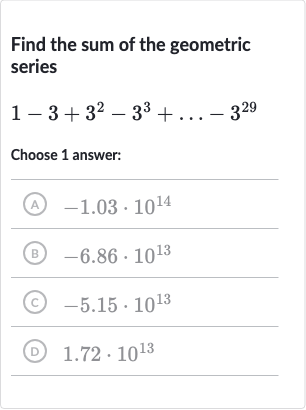Full solution
Q. Find the sum of the geometric seriesChoose answer:(A) (B) (C) (D)
- Identify Geometric Series: The given series is a geometric series with the first term and the common ratio . The sum of a finite geometric series can be calculated using the formula , where is the number of terms.
- Determine Number of Terms: First, we need to determine the number of terms in the series. Since the series starts at (which is ) and goes up to , and the powers of increase by each time, there are terms in total.
- Apply Sum Formula: Now we can apply the formula for the sum of a geometric series: . Here, , , and .
- Calculate Numerator: Plugging the values into the formula, we get .
- Calculate Denominator: Calculating the numerator: . Since is a very large number, we can leave it in the exponential form for now.
- Substitute Values: Calculating the denominator: .
- Calculate Exponential Value: Now we have . To find the exact value of , we can use a calculator or a computer.
- Perform Subtraction: Using a calculator, we find that is approximately .
- Divide by : Substituting this value into our sum expression, we get .
- Express in Scientific Notation: Now we perform the subtraction in the numerator: . Since is negligible compared to , we can approximate this as .
- Express in Scientific Notation: Now we perform the subtraction in the numerator: . Since is negligible compared to , we can approximate this as .Finally, we divide by : .
- Express in Scientific Notation: Now we perform the subtraction in the numerator: . Since is negligible compared to , we can approximate this as .Finally, we divide by : .We can write in scientific notation as .

